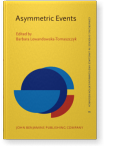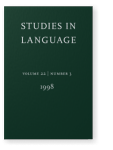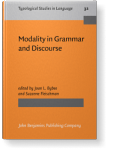Frank Lichtenberk
List of John Benjamins publications for which Frank Lichtenberk plays a role.
2018 The diachrony of Oceanic possessive classifiers The Diachrony of Classification Systems, McGregor, William B. and Søren Wichmann (eds.), pp. 165–200 | Chapter
With just a small number of exceptions, Oceanic languages have multiple types of attributive possessive constructions that involve a more or less elaborate system of possessive classifiers. Constructions with possessive classifiers usually serve to express alienable possession. A different… read more
2017 Lexical and grammatical flexibility in Toqabaqita: Workshop on Lexical Flexibility in Oceanic Languages, 23–24 October 2014 Lexical flexibility in Oceanic languages, Lier, Eva van (ed.), pp. 496–501 | Article
2013 The rise and demise of possessive classifiers in Austronesian Historical Linguistics 2011: Selected papers from the 20th International Conference on Historical Linguistics, Osaka, 25-30 July 2011, Kikusawa, Ritsuko and Lawrence A. Reid (eds.), pp. 199–225 | Article
Some Austronesian languages make a grammatical distinction between alienable and inalienable possession, with further distinctions in alienable possession. While the rise of the alienable–inalienable contrast may be due to contact with Papuan languages, the development of the contrasts within… read more
2011 Nominalizations in Toqabaqita and closely related languages Nominalization in Asian Languages: Diachronic and typological perspectives, Yap, Foong Ha, Karen Grunow-Hårsta and Janick Wrona (eds.), pp. 685–720 | Article
The paper has two major focuses. One is the nominalizing suffixes found in Toqabaqita, an Oceanic language, and its near relatives, in particular those nominalizers that are of some antiquity and one recent replacement. The other one is certain aspects of nominalizations in Toqabaqita. One feature… read more
2008 9. Asymmetry reversal Asymmetric Events, Lewandowska-Tomaszczyk, Barbara (ed.), pp. 173–193 | Article
Subordination is sometimes said to be characterized by a cognitive asymmetry between a matrix clause and its complement clause: the matrix clause is the profile determinant (Langacker 1991); the state of affairs expressed in the matrix clause but not the one expressed in the subordinate clause is… read more
2007 36. Reciprocals and related meanings in To’aba’ita Reciprocal Constructions, Nedjalkov, Vladimir P. (ed.), pp. 1547–1571 | Chapter
2005 Inclusive-exclusive in Austronesian: An opposition of unequals Clusivity: Typology and case studies of the inclusive–exclusive distinction, Filimonova, Elena (ed.), pp. 261–289 | Chapter
2005 Inalienability and possessum individuation* Linguistic Diversity and Language Theories, Frajzyngier, Zygmunt, Adam Hodges and David S. Rood (eds.), pp. 339–362 | Article
2003 Directionality and displaced directionality in Toqabaqita Motion, Direction and Location in Languages: In honor of Zygmunt Frajzyngier, Shay, Erin and Uwe Seibert (eds.), pp. 151–175 | Article
2002 Review of Besnier (): Tuvaluan: A Polynesian language of the Central Pacific Studies in Language 26:3, pp. 712–716 | Review
2002 11. Posture verbs in Oceanic The Linguistics of Sitting, Standing and Lying, Newman, John (ed.), pp. 269–314 | Chapter
2000 Reciprocals without reflexives Reciprocals: Forms and functions, Frajzyngier, Zygmunt and Traci Walker (eds.), pp. 31–62 | Article
1997 Head-Marking and Objecthood Essays on Language Function and Language Type: Dedicated to T. Givón, Bybee, Joan L., John Haiman and Sandra A. Thompson (eds.), pp. 301–322 | Article
1996 Patterns of Anaphora in To’aba’ita Narrative Discourse Studies in Anaphora, Fox, Barbara A. (ed.), pp. 379–412 | Article
1995 Apprehensional Epistemics Modality in Grammar and Discourse, Bybee, Joan L. and Suzanne Fleischman (eds.), pp. 293–328 | Article
1991 On the gradualness of grammaticalization Approaches to Grammaticalization: Volume I. Theoretical and methodological issues, Traugott, Elizabeth Closs and Bernd Heine (eds.), pp. 37–80 | Article
1988 The Pragmatic Nature of Nominal Anaphora in To'Aba'Ita Studies in Language 12:2, pp. 299–344 | Article
1983 Semantic Extension in the Colour Lexicon Studies in Language 7:1, pp. 25–64 | Article
A cross-linguistic study of the figurative use of colour terms reveals the existence of both language-idiosyncratic developments and general tendencies. It is argued that both types of development are ultimately grounded in the experience of the world by the speakers of the languages. Furthermore,… read more


















